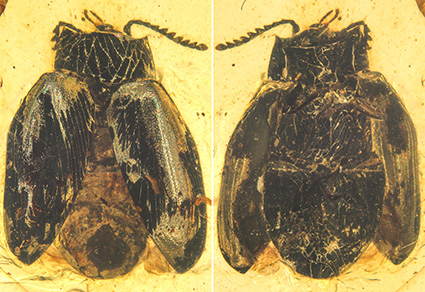Abstract
Artematopodid fossils from the mid-Cretaceous Burmese amber are reported for the first time, represented by three species in two genera. Bipogonia Li, Kundrata & Cai gen. nov. with two species, B. trivialis Li, Kundrata & Cai sp. nov. and B. fortis Li, Kundrata & Cai sp. nov., is mainly characterized by the distinctly serrate antennae, mandibles with both apical and subapical teeth, and prosternum without paired longitudinal ridges. Carinibipogonia xiai Li, Kundrata & Cai gen. et sp. nov. shares with Bipogonia the distinctly serrate antennae and mandibles with both apical and subapical teeth but differs mainly in the prosternum with short paired longitudinal ridges. Based on their morphology, the two new genera might be related to the extant Allopogonia; however, this needs to be tested in the future with a phylogenetic framework.
References
Cai, C., Lawrence, J.F., Ślipiński, A. & Huang, D. (2015) Jurassic artematopodid beetles and their implications for the early evolution of Artematopodidae (Coleoptera). Systematic Entomology, 40, 779–788. https://doi.org/10.1111/syen.12131
Cai, C., Fu, Y. & Huang, D. (2020) A large artematopodid beetle (Coleoptera: Elateroidea: Artematopodidae) from the Early Cretaceous of China and its systematic position. Cretaceous Research, 105, 103986. https://doi.org/10.1016/j.cretres.2018.10.009
Cai, C., Tihelka, E., Giacomelli, M., Lawrence, J.F., Ślipiński, A., Kundrata, R., Yamamoto, S, Thayer, M.K., Newton, A.F., Leschen, R.A.B., Gimmel, M.L, Lü, L., Engel, M.S., Bouchard, P., Huang, D., Pisani, D. & Donoghue, P.C.J. (2022) Integrated phylogenomics and fossil data illuminate the evolution of beetles. Royal Society Open Science, 9, 211771. https://doi.org/10.1098/rsos.211771
Crowson, R.A. (1973) On a new superfamily Artematopoidea of polyphagan beetles, with the definition of two new fossil genera from the Baltic Amber. Journal of Natural History, 7, 225–238. https://doi.org/10.1080/00222937300770181
Douglas, H.B., Kundrata, R., Brunke, A.J., Escalona, H.E., Chapados, J.T., Eyres, J., Richter, R., Savard, K., Ślipiński, A., McKenna, D. & Dettman, J.R. (2021) Anchored phylogenomics, evolution and systematics of Elateridae: Are all bioluminescent Elateroidea derived click beetles? Biology, 10, 451. https://doi.org/10.3390/biology10060451
Gimmel, M.L. & Bocakova, M. (2015) A new extant species of Electribius Crowson from Honduras (Coleoptera: Elateroidea: Artematopodidae). Zootaxa, 3926 (2), 296–300. https://doi.org/10.11646/zootaxa.3926.2.10
Háva, J. (2015) A new Electribius Crowson, 1973 species from Baltic amber (Coleoptera: Artematopodidae). Arquivos Entomolóxicos, 14, 67–69.
Hopping, R. (1936) A revision of the genus Macropogon Motsch. The Pan-Pacific Entomologist, 12, 45–48.
Hörnschemeyer, T. (1998) New species of Electribius Crowson 1973 (Coleoptera: Artematopodidae) from Baltic amber. Paläontologische Zeitschrift, 72, 299–305. https://doi.org/10.1007/BF02988360
Kundrata, R., Bocakova, M. & Bocak, L. (2013) The phylogenetic position of Artematopodidae (Coleoptera: Elateroidea), with description of the first two Eurypogon species from China. Contributions to Zoology, 82, 199–208. https://doi.org/10.1163/18759866-08204004
Kundrata, R., Bocakova, M. & Bocak, L. (2014) The comprehensive phylogeny of the superfamily Elateroidea (Coleoptera: Elateriformia). Molecular Phylogenetics and Evolution, 76, 162–171. https://doi.org/10.1016/j.ympev.2014.03.012
Lawrence, J.F. (2005) Brevipogon, a new genus of North American Artematopodidae (Coleoptera). The Coleopterists Bulletin, 59, 223–236. https://doi.org/10.1649/749
Lawrence, J.F. (2010) Artematopodidae Lacordaire, 1857. In: Leschen, R.A.B., Beutel, R.G. & Lawrence, J.F. (Eds.), Handbook of Zoology, Arthropoda: Insecta, Coleoptera, beetles. Vol. 2. morphology and systematics (Elateroidea, Bostrichiformia, Cucujiformia partim). Walter de Gruyter, Berlin, pp. 42–47. https://doi.org/10.1515/9783110911213.42
Lawrence, J.F., Ślipiński, A., Seago, A.E., Thayer, M.K., Newton, A.F. & Marvaldi, A.E. (2011) Phylogeny of the Coleoptera based on morphological characters of adults and larvae. Annales Zoologici, 61, 1–217. https://doi.org/10.3161/000345411X576725
Li, Y.-D., Huang, D.-Y. & Cai, C.-Y. (2021) Revisiting the systematic positions of two “Notocupes” species from the Lower Cretaceous of South China (Coleoptera: Polyphaga). Zootaxa, 5005 (1), 86–90. https://doi.org/10.11646/zootaxa.5005.1.7
McKenna, D.D., Wild, A.L., Kanda, K., Bellamy, C.L., Beutel, R.G., Caterino, M.S., Farnum, C.W., Hawks, D.C., Ivie, M.A., Jameson, M.L., Leschen, R.A.B., Marvaldi, A.E., McHugh, J.V., Newton, A.F., Robertson, J.A., Thayer, M.K., Whiting, M.F., Lawrence, J.F., Ślipiński, A., Maddison, D.R. & Farrell, B.D. (2015) The beetle tree of life reveals that Coleoptera survived end-Permian mass extinction to diversify during the Cretaceous terrestrial revolution. Systematic Entomology, 40, 835–880. https://doi.org/10.1111/syen.12132
McKenna, D.D., Shin, S., Ahrens, D., Balke, M., Beza-Beza, C., Clarke, D.J., Donath, A., Escalona, H.E., Friedrich, F., Letsch, H., Liu, S., Maddison, D., Mayer, C., Misof, B., Murin, P.J., Niehuis, O., Peters, R.S., Podsiadlowski, L., Pohl, H., Scully, E.D., Yan, E.V., Zhou, X., Ślipiński, A. & Beutel, R.G. (2019) The evolution and genomic basis of beetle diversity. Proceedings of the National Academy of Sciences, USA, 116, 24729–24737. https://doi.org/10.1073/pnas.1909655116
Ross, A.J. (2019) Burmese (Myanmar) amber checklist and bibliography 2018. Palaeoentomology, 2, 22–84. https://doi.org/10.11646/palaeoentomology.2.1.5
Ross, A.J. (2020) Supplement to the Burmese (Myanmar) amber checklist and bibliography, 2019. Palaeoentomology, 3, 103–118. https://doi.org/10.11646/palaeoentomology.3.1.14
Ross, A.J. (2021) Supplement to the Burmese (Myanmar) amber checklist and bibliography, 2020. Palaeoentomology, 4, 57–76. https://doi.org/10.11646/palaeoentomology.4.1.11
Ross, A.J. (2022) Supplement to the Burmese (Myanmar) amber checklist and bibliography, 2021. Palaeoentomology, 5, 27–45. https://doi.org/10.11646/palaeoentomology.5.1.4
Sakai, M. (1982) Occurrence of the genus Eurypogon Motschulsky in Japan and Taiwan (Coleoptera: Artematopidae). Transactions of the Shikoku Entomological Society, 16, 51–61.
Wang, C.-B. & Liu, H.-Y. (2021) Eurypogon sanzang sp. n. from Henan, China (Coleoptera: Artematopodidae: Artematopodinae). Japanese Journal of Systematic Entomology, 27, 37–42.
Wu, H., Coty, D. & Ding, M. (2015) First artematopodid beetle in Mexican amber and its biogeographic implications (Coleoptera, Artematopodidae). Alcheringa, 39, 508–513. https://doi.org/10.1080/03115518.2015.1041306
Yoshitomi, H. (2018) Description of the male of Eurypogon jaechi Kundrata, Bocakova, and Bocak (Coleoptera: Artematopodidae). The Coleopterists Bulletin, 72, 246–248. https://doi.org/10.1649/0010-065X-72.2.246
Zhang, S.-Q., Che, L.-H., Li, Y., Liang, D., Pang, H., Ślipiński, A. & Zhang, P. (2018) Evolutionary history of Coleoptera revealed by extensive sampling of genes and species. Nature Communications, 9, 205. https://doi.org/10.1038/s41467-017-02644-4


